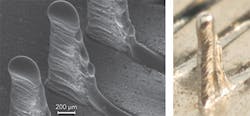Laser-GMA hybrid joining of thick high-strength steels
Supplies highly reproducible results, high-quality output
By Herbert Staufer
More Industrial Laser Solutions Articles |
Laser welding in commercial furniture manufacturing Laser-GMA hybrid joining of thick high-strength steels Laser processing steel floors for containers |
Users of industrial welding equipment in many fields, for example, shipbuilding, plant and apparatus engineering, and/or pipeline construction, insist on both high product value and enhanced performance. To meet these requirements, often estimated as a "make or break" factor, appears just possible by using continuously advanced and innovative equipment. This proves especially true when it comes to high-strength steels.
In fusion welding technology, both high welding speeds and good gap-bridging ability are highly desirable objectives. However, physical limitations of conventional joining processes, like gas metal arc welding (GMAW), often impede achievement of both attributes simultaneously. Laser hybrid single wire GMAW and GMA-tandem welding have become well established and industrially used welding processes, permitting a considerable expansion of the application envelope. Pairing two arcs with a laser beam, however, may be deemed a quantum leap in fusion welding with respect to both performance and quality.
A specific shipyard welding application, i.e., joining bulb bars as stiffener profiles to web plates, is described in this article. Practical welding trials implementing original structural shipbuilding steel grades and parts prove that the solid-state laser-GMA hybrid welding process can supply both highly reproducible results and high-quality output. Now, solid-state laser-GMA hybrid welding employing highly advanced hybrid welding heads can reduce costs and be an efficient and quality alternative to submerged arc welding (SAW).
Application of laser-GMA hybrid in pipelines
Semi-automatic gas shielded metal arc girth welding (GMAW) is currently used to produce both on- and offshore pipelines. Time needed per weld joint is regularly determined by the number of weld passes, varying depending on the wall thickness of the pipe.
The attempt to continuously reduce running costs in the pipeline industry has led to an enhanced implementation of sophisticated and innovative technologies. For example, higher-strength parent materials like API 5LX-80 and above -- allowing a considerable wall-thickness reduction -- have been incorporated into modern pipe laying. Multifiller wire GMAW (GMAW-tandem) is an example as an attempt to integrate advanced welding processes to increase both efficiency and production quality. Nd:YAG lasers were made applicable, meanwhile, to supersede the CO2 laser that had been regularly used. This, due to both weld size and efficiency produced by both laser types, may be considered quite similar.
References 1 and 2 provide valuable information for the utilization of CO2 lasers on API 5L Grade X-80 steel. Practical welding trials were carried out in this reference using a 12 kW CO2 laser to autogenously weld 13-mm wall-thickness square groove butt joints. Welding speeds obtained for single- and double-sided operation modes were 0.75 and 1.65 m/min, respectively. Good values are reported for weld-joint ductility, strength, and toughness. The references hereafter describe a way to reduce the considerably high welding cost, which represents a major fraction of the total pipeline production costs. It should be noted that the industry is always seeking ways of improving the efficiency of a given project’s performance: the implementation of advanced joining processes has great potential to achieve this objective. The welding economics of pipeline construction are primarily determined by two major aspects: root pass welding and fill- and cap-pass welding.
Experimental set-up and welding results
The specimen diameter was 190 mm with a wall thickness of 12 mm. Root pass welding was performed without backing at 70 cm/min welding speed. Approximately two-thirds of the groove cross-section was filled up by the root run; only one second layer comprising three passes at 140 cm/min welding speed was necessary to accomplish the entire weld. See the right part of FIGURE 1.
Very good results are reported from the field when using this system in the workshop. It should be noted, however, that this concept is restricted to ferromagnetic materials such as iron base alloys or steel.
Laser-GMA hybrid process for welding in shipbuilding
In shipbuilding, bulb bar profiles are regularly used to increase stiffness of subassembly and sectional parts. The average thickness of these profiles, often referred to as stiffeners, lies between 4.0 and 8.0 mm. As yet, the most widely used joining process is SAW. However, a great drawback needs to be overcome, that is, the high heat input and low or moderate welding speed, resulting in warpage and distortion. This again may require an undesirable amount of rework such as flame straightening. The optimal solution in this respect would be using the laser beam process by itself, but tolerances, arising from preparation and pre-assembly, simply impede applying the laser alone. Laser-GMA hybrid welding, however, is capable of solving the issues. This has already been confirmed industrially by an impressive CO2 laser-GMA hybrid welding system, installed and used for many years at the German shipyard Meyer Werft in Papenburg. For this kind of industry, fillet welds at a T-joint are used to weld the stiffener [3]. The next section describes the single-sided full penetration welding with a solid-state laser of such stiffener profiles.
Variation of the stiffener thickness
FIGURE 2 depicts bulb bar macro sections applying 4.0, 6.0, and 8.0 mm stiffener wall thickness. Particular consideration must be given to the brightly marked area within the fusion zone. Depending on the stiffener thickness, at given conditions (see TABLE 1) this area varies, as the laser beam (focal diameter 0.9 mm) proves only restricted (focal diameter, length, and position) for wholly covering the full cross-section. The area, representing the unit volume, would actually need to be melted by the GMAW process, but could also be reduced by expanding the laser beam focal diameter. As is known, however, the latter may reduce both fusion depth and/or welding speed, requiring a rising laser power for compensation. Therefore, a balanced relationship between laser power, GMAW deposition rate, and welding speed is necessary to be established and maintained throughout the welding sequence.
FIGURE 3 shows single-sided full penetration welding of bulb bar profiles in shipbuilding on a T-joint, while the web thickness was measured at approximately 10 mm (TABLE 2). The inclination of the laser beam was set with 12° to the horizontal plate, and the GMAW torch was arranged with 45° trailing.
Summary
Great benefits may be achieved by using the new laser hybrid + GMA-tandem technology, combining laser hybrid single-wire GMAW with GMA tandem welding. A wide range of welding applications may be applicable with this new technological concept, in particular, industries where pure laser welding has its physical limits and even where the conventional single-wire-operated laser hybrid welding is not sufficient to achieve high weld performance paired with high quality. It has been shown that this sophisticated process is capable of reducing capital costs for laser power and of decreasing operation costs by lowering the weld cycle times and again increasing the output. With regard to weld quality aspects, the process improves both mechanical and metallurgical properties of the weldments. Choosing appropriate consumables may allow the latter, and adjusting the peripheral parameters like wire feed and welding speed may permit the process user to improve the former.
A specific shipyard welding application, i.e., joining bulb bars as stiffener profiles to web plates, was also described in this article. The usually employed submerged arc partial penetration welding often leads to undesirable drawbacks such as distortion and warpage, which necessitate extensive reworking by flame straightening. This generates additional cost. An approach for both reducing cost and improving quality is to use solid-state laser-GMA hybrid welding, capable of covering the whole range of joints to be carried out.
The hybrid welding head is suggested as a crucial key for successful implementation of high power (≤ 10 kW) solid-state laser-GMA hybrid welding. It could be shown that incorporating the special shipbuilding considerations into the development process can finally lead to a tailored product capable of fully meeting the particular requirements. Practical welding trials implementing original structural shipbuilding steel grades and parts could prove that the solid-state laser-GMA hybrid welding process is able to supply both highly reproducible results and high quality output. Consequently, solid-state laser-GMA hybrid welding employing highly advanced hybrid welding heads can reduce costs and improve quality over SAW.
References
1. D. Yapp, J. Denney, J. Eastman, and M. Johnson, "Nd: YAG laser welding of high strength pipeline steels," ICAWT‘ 99 International Conference on Advances in Welding Technology, Galveston, TX, 1999.
2. E.M. Breinan and C.M. Banas, "Preliminary evaluation of laser welding of X80 arctic pipeline steel," Welding Research Council Bulletin 201, Dec. 1974, pp. 47-57.
3. U. Dilthey and H. Keller, "Deployment of hybrid and hydra welding processes to boost efficiency in shipbuilding," DVS 216, pp. 56ff.
4. H. Staufer, C. Kammerhuber, and S. Egerland, "Applying the solid-state laser-GMA hybrid process for single-sided full penetration welding of bulb bar profiles in shipbuilding," International Institute of Welding, Annual Assembly – Chennai, 2013.
Herbert Staufer([email protected]) is the head of high-power welding within the R&D of Fronius International GmbH (www.fronius.com), Wels, Austria.
More Industrial Laser Solutions Current Issue Articles
More Industrial Laser Solutions Archives Issue Articles





